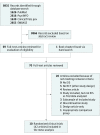Comparison of Early Intervention Services vs Treatment as Usual for Early-Phase Psychosis: A Systematic Review, Meta-analysis, and Meta-regression
- PMID: 29800949
- PMCID: PMC6137532
- DOI: 10.1001/jamapsychiatry.2018.0623
Comparison of Early Intervention Services vs Treatment as Usual for Early-Phase Psychosis: A Systematic Review, Meta-analysis, and Meta-regression
Abstract
Importance: The value of early intervention in psychosis and allocation of public resources has long been debated because outcomes in people with schizophrenia spectrum disorders have remained suboptimal.
Objective: To compare early intervention services (EIS) with treatment as usual (TAU) for early-phase psychosis.
Data sources: Systematic literature search of PubMed, PsycINFO, EMBASE, and ClinicalTrials.gov without language restrictions through June 6, 2017.
Study selection: Randomized trials comparing EIS vs TAU in first-episode psychosis or early-phase schizophrenia spectrum disorders.
Data extraction and synthesis: This systematic review was conducted according to PRISMA guidelines. Three independent investigators extracted data for a random-effects meta-analysis and prespecified subgroup and meta-regression analyses.
Main outcomes and measures: The coprimary outcomes were all-cause treatment discontinuation and at least 1 psychiatric hospitalization during the treatment period.
Results: Across 10 randomized clinical trials (mean [SD] trial duration, 16.2 [7.4] months; range, 9-24 months) among 2176 patients (mean [SD] age, 27.5 [4.6] years; 1355 [62.3%] male), EIS was associated with better outcomes than TAU at the end of treatment for all 13 meta-analyzable outcomes. These outcomes included the following: all-cause treatment discontinuation (risk ratio [RR], 0.70; 95% CI, 0.61-0.80; P < .001), at least 1 psychiatric hospitalization (RR, 0.74; 95% CI, 0.61-0.90; P = .003), involvement in school or work (RR, 1.13; 95% CI, 1.03-1.24; P = .01), total symptom severity (standardized mean difference [SMD], -0.32; 95% CI, -0.47 to -0.17; P < .001), positive symptom severity (SMD, -0.22; 95% CI, -0.32 to -0.11; P < .001), and negative symptom severity (SMD, -0.28; 95% CI, -0.42 to -0.14; P < .001). Superiority of EIS regarding all outcomes was evident at 6, 9 to 12, and 18 to 24 months of treatment (except for general symptom severity and depressive symptom severity at 18-24 months).
Conclusions and relevance: In early-phase psychosis, EIS are superior to TAU across all meta-analyzable outcomes. These results support the need for funding and use of EIS in patients with early-phase psychosis.
Conflict of interest statement
Figures


Comment in
-
Early Intervention-An Implementation Challenge for 21st Century Mental Health Care.JAMA Psychiatry. 2018 Jun 1;75(6):545-546. doi: 10.1001/jamapsychiatry.2018.0621. JAMA Psychiatry. 2018. PMID: 29801060 No abstract available.
-
Disturbing Lack of Early Intervention Studies in Bipolar Disorder.JAMA Psychiatry. 2018 Nov 1;75(11):1201-1202. doi: 10.1001/jamapsychiatry.2018.2396. JAMA Psychiatry. 2018. PMID: 30422264 No abstract available.
-
Disturbing Lack of Early Intervention Studies in Bipolar Disorder-Reply.JAMA Psychiatry. 2018 Nov 1;75(11):1202-1203. doi: 10.1001/jamapsychiatry.2018.2399. JAMA Psychiatry. 2018. PMID: 30422265 No abstract available.
References
-
- Kahn RS, Sommer IE, Murray RM, et al. . Schizophrenia. Nat Rev Dis Primers. 2015;1:15067. - PubMed
Publication types
MeSH terms
Grants and funding
LinkOut - more resources
Full Text Sources
Other Literature Sources
Medical

